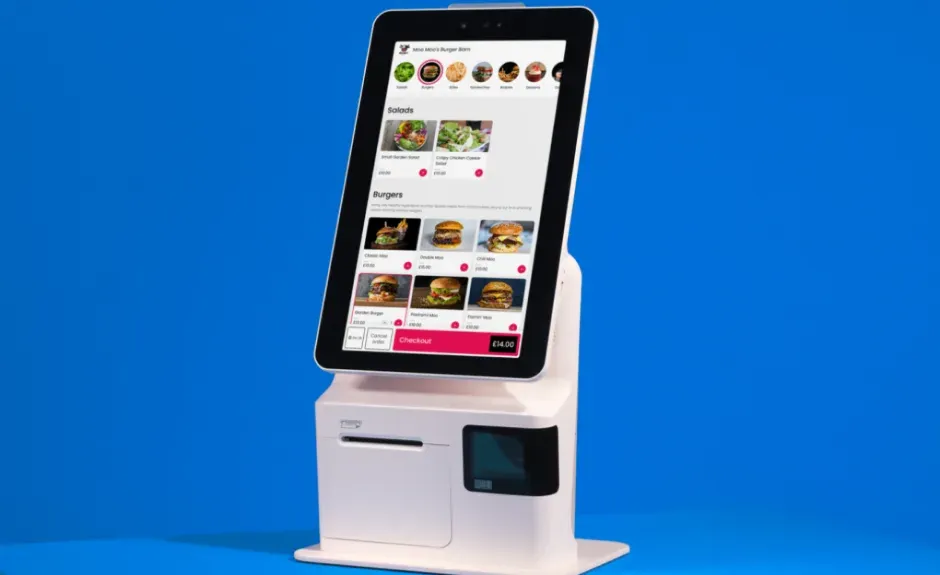How to design your kiosk layout for optimal customer flow
The rise of self-service kiosks in quick service restaurants (QSRs) has revolutionised the way customers order and experience fast food. These sleek, touchscreen machines are transforming the order process, reducing wait times and alleviating the burden on staff.
Kiosks serve several purposes in a QSR setting, from controlling order flow to providing tech-savvy customers with a better, more personalised experience. As restaurants grapple with perennial staffing challenges, exacerbated by the COVID-19 pandemic, kiosks offer a solution by taking over some or much of the ordering process, allowing workers to be used elsewhere.
However, the effectiveness of kiosks largely depends on their placement within the restaurant. A well-designed kiosk layout is crucial for maximising their utility, enhancing customer experience, streamlining operations, and ultimately driving sales.

What is a QSR kiosk layout?
A QSR kiosk layout is a strategic arrangement of self-service kiosks within a quick service restaurant environment. The goal is to optimise customer flow, improve service efficiency, and boost sales by strategically placing kiosks at key points in the customer journey.
Effective kiosk layouts take into account factors such as:
- Visibility: Kiosks should be placed in high-traffic areas, ensuring they are easily spotted by customers as they enter the restaurant.
- Accessibility: The layout should ensure kiosks are easily accessible to all customers, including those with disabilities, with sufficient space around each unit to prevent congestion.
- Integration with restaurant flow: Kiosks should be positioned to complement the natural flow of the restaurant, from entrance to order pickup, without disrupting the overall customer experience.
By analysing customer behaviour patterns and strategically placing kiosks, QSRs can guide customers towards self-service ordering, reducing reliance on traditional counter service. This shift not only streamlines operations but also empowers customers, giving them greater control over their ordering experience.
A well-designed QSR kiosk layout seamlessly integrates technology into the restaurant environment, enhancing efficiency and customer satisfaction. By understanding the principles of effective kiosk placement, QSR operators can harness the full potential of these powerful tools, driving sales and improving the overall dining experience.
How to Design Your Kiosk Layout for Optimal Customer Flow
Analyse Customer Flow Patterns
To effectively design your kiosk layout, begin by examining how patrons navigate your establishment. Analyse foot traffic to identify areas where customer interactions naturally occur. This involves tracking movement patterns to determine strategic spots where kiosks can be placed to capture attention and facilitate use. By positioning kiosks where they align with customer activities, you ensure they become a seamless part of the ordering process, reducing wait times and enhancing service efficiency.
Strategic Kiosk Placement
Thoughtful kiosk placement can transform the ordering experience and streamline operations. Install kiosks at pivotal points like entrances or along primary pathways to engage customers as they enter the venue. Ensure they are spaced to allow smooth flow and accessibility for all visitors. By situating kiosks in locations that naturally guide customers toward self-service, you encourage their adoption without overwhelming them. Avoid displaying traditional tills prominently to subtly shift customer behaviour towards using kiosks as the main ordering method.
Enhance User Experience with Intuitive Design
Improving the user experience is essential for maximising kiosk effectiveness. Implement clear visual cues and straightforward instructions to assist customers in navigating the self-service process. Design the interface to be user-friendly, with logically organised menus that highlight popular items and current promotions. By focusing on intuitive design, you simplify the ordering process, boost customer satisfaction, and increase the likelihood of kiosk usage.
Integrate with Existing Systems
Integrating kiosks with your existing operational systems ensures a seamless function within your restaurant. Link kiosks to the kitchen and point-of-sale systems to facilitate efficient order processing and minimise errors. This connectivity allows for real-time data updates and accurate order tracking. Regular software updates maintain optimal performance and security, ensuring kiosks operate smoothly. By aligning kiosks with current systems, you maintain operational coherence that benefits both staff and customers.
Tips on Optimising Kiosk Efficiency
Regularly Review and Adjust Layout
To enhance kiosk efficiency, stay proactive in assessing customer movement and interaction with kiosks. Regularly evaluate how effectively kiosks serve customers in their current positions. This process helps identify necessary adjustments to maintain optimal placement, ensuring kiosks are always in high-impact areas. By observing changes in customer behaviour or preferences, you can reposition kiosks to better meet demand, ultimately improving the overall service flow and customer satisfaction.
Gather Customer Feedback
Customer feedback is a valuable resource for improving kiosk operations. Implement mechanisms to collect insights from users about their experiences and any challenges they face. This data can inform adjustments to both the placement and functionality of kiosks, ensuring they meet customer expectations. By addressing feedback, you can refine the user interface and other aspects of the kiosk experience, creating a more tailored and efficient service that resonates with your audience.
Train Staff to Assist Customers
Providing your staff with the necessary training to support customers using kiosks is crucial. Equip them with knowledge about the kiosk system and its features so they can effectively guide users through the ordering process. Staff should be prepared to assist with any technical issues and offer tips to enhance the customer experience. By fostering a supportive environment, your team can encourage greater kiosk adoption, helping customers see the benefits of self-service ordering and ensuring a seamless transition from traditional methods.
By strategically designing your kiosk layout, you can optimise customer flow, enhance the user experience, and drive sales in your QSR. Implementing these best practices and staying proactive in gathering feedback will ensure your kiosks continue to deliver value and improve overall restaurant efficiency. If you're ready to take your QSR to the next level with cutting-edge kiosk technology, contact us today to learn how we can help you streamline your operations and boost your bottom line.


